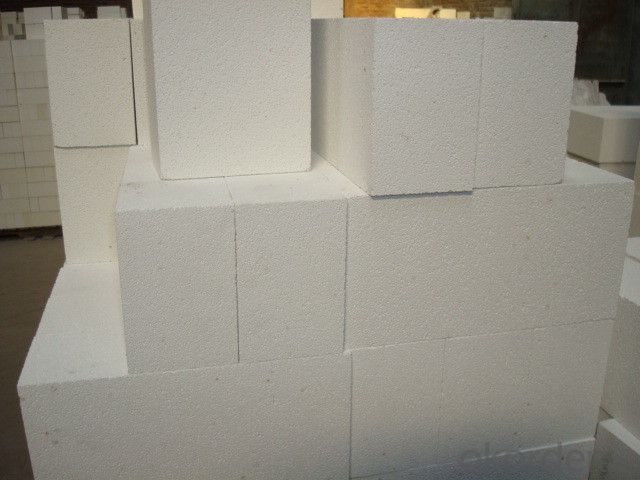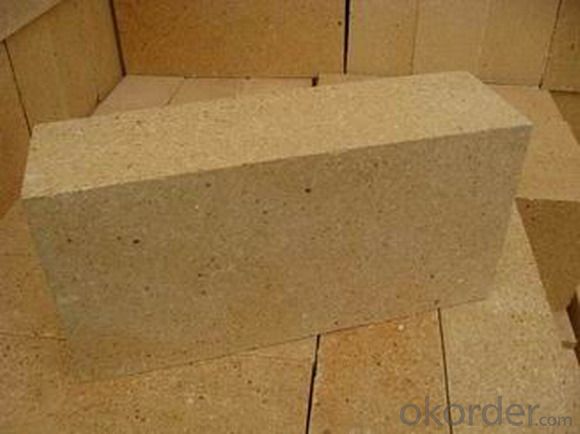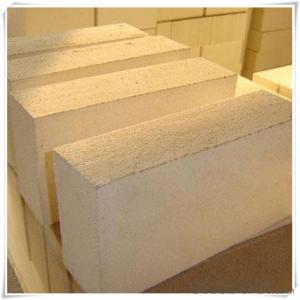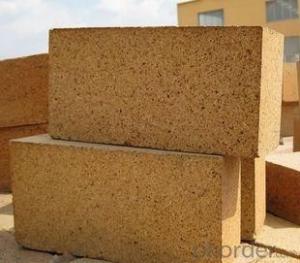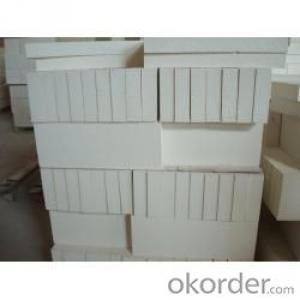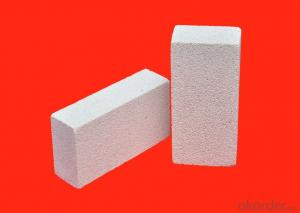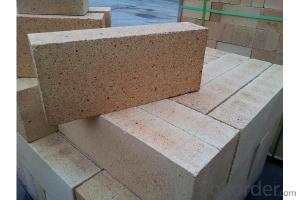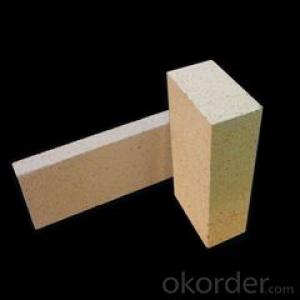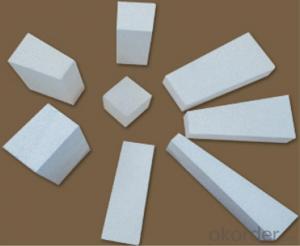Insulating Fire Brick:Low Conductivity Mullite Refractory Brick
- Loading Port:
- Tianjin
- Payment Terms:
- TT OR LC
- Min Order Qty:
- 20 m.t.
- Supply Capability:
- 10000 m.t./month
OKorder Service Pledge
OKorder Financial Service
You Might Also Like
CNBM conforms strictly to the requirements of ISO 9000 quality control system during the production. MSDS is also available if you want. The thermal insulation fire clay brick meet with the requirements of ASTM & JIS standards. So pls stay cool with our quality.
Brief discription for Alumina Fire Brick
CNBM Alumina Fire Brick are classified according to alumina content ranging from 48% to 90%.
CNBM Alumina Fire Brick are commonly used in blast furnace, hot blast furnace, the roof of electric furnace, teeming ladle, rotary kiln, regenerator, etc.
Brief features for Alumina Fire Brick
◆Low thermal conductivity
◆Excellent acid and base slagging resistance
◆High refractoriness
◆Excellent thermal shock resistance
◆Excellent mechanical strength
◆Good spalling resistance and wear resistance.
◆Good corrosion resistance.
◆High-temperature creep rate is quite low.
◆Good volume stability at high temperature.
◆Low bulk density, low thermal conductivity, good thermal insulation performance.
Technical data for high aluminia bricks
ITEM | UAL48 | UAL55 | UAL65 | UAL75 | UAL80 | UAL85 | ALP80 |
Refractoriness, ℃ | 1750 | 1770 | 1790 | 1790 | 1810 | 1810 | 1810 |
Apparent Porosity,% | 22 | 22 | 23 | 23 | 20 | 20 | 18 |
C.C.S, Mpa | 39 | 44 | 49 | 53 | 55 | 60 | 100 |
Refractories Under Load (0.2Mpa),℃ | 1420 | 1470 | 1500 | 1520 | 1500 | 1520 | 1550 |
Reheating Linear Change,% | 1450℃x2h 0.1~-0.4 | 1500℃x2h 0.1~-0.4 | 1500℃x2h 0.1~-0.4 | 1500℃x2h 0.1~-0.4 | 1550℃x2h -0.5~+0.5 | 1550℃x2h -0.5~+0.5 | 1550℃x2h -0.5~+0.5 |
Al2O3 Content , % | 48 | 55 | 65 | 75 | 80 | 85 | 82 |
Why us
Professional fire brick manufacturer. We have being specialized in producing refractory fireclay brick for more than 40 years so that we can guarantee a stable quality.
Guaranteed quality. Our production process conforms strictly to the requirements of ISO9000 quality management system. Quality inspection is carried out in every links of our production. SGS third party inspection is available.
Sound after sales service. We provide sound after sales service. We provide 24 hours’ consultation service. We are ready to answer your consultations at any time.
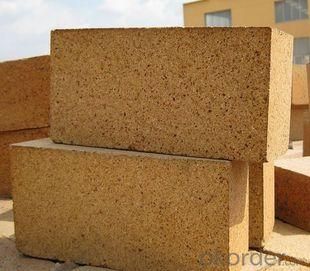

- Q: Can insulating fire bricks be used in the construction of hot blast stoves?
- Yes, insulating fire bricks can be used in the construction of hot blast stoves. Insulating fire bricks are designed to have low thermal conductivity, making them effective at reducing heat loss. Hot blast stoves require high temperatures to be maintained for efficient operation, and insulating fire bricks can help in achieving this by minimizing heat transfer to the outer surface of the stove. These bricks also have good insulation properties, which help to conserve energy and improve the overall efficiency of the stove. Additionally, insulating fire bricks are resistant to thermal shock, which is important in hot blast stove applications where frequent temperature fluctuations occur.
- Q: Can insulating fire bricks be used in outdoor fire pits?
- Certainly, outdoor fire pits can make use of insulating fire bricks. These bricks are specifically engineered to endure high temperatures, rendering them suitable for fire pit applications. They are crafted from heat-resistant materials like ceramic fibers or refractory substances, which aid in preserving the heat within the fire pit. Moreover, insulating fire bricks possess a lightweight composition and are effortless to install, making them a practical selection for outdoor fire pits. Nevertheless, it is crucial to bear in mind that these bricks may not possess the same level of durability as regular fire bricks. Thus, they might necessitate more frequent replacement if exposed to extreme temperatures or harsh weather conditions.
- Q: Are insulating fire bricks easy to handle and install?
- Yes, insulating fire bricks are generally easy to handle and install. They are lightweight and can be easily transported and positioned in place. Additionally, they are designed with interlocking shapes or grooves that make it convenient to stack and secure them together during installation. Overall, insulating fire bricks are user-friendly and straightforward to work with.
- Q: Can insulating fire bricks be used in the construction of lime production molds?
- Yes, insulating fire bricks can be used in the construction of lime production molds. Insulating fire bricks are designed to have high thermal resistance, making them ideal for applications that require insulation and protection from high temperatures. Lime production molds often involve high temperatures during the firing process, and insulating fire bricks can help maintain the desired temperature and prevent heat loss. Additionally, the insulating properties of these bricks can help reduce energy consumption and improve the efficiency of the lime production process. Therefore, using insulating fire bricks in the construction of lime production molds is a suitable choice.
- Q: Are insulating fire bricks suitable for use in furnaces?
- Yes, insulating fire bricks are suitable for use in furnaces. They have excellent thermal insulation properties, high temperature resistance, and can withstand the harsh conditions inside a furnace without cracking or breaking. These bricks help to maintain consistent temperatures, reduce heat loss, and improve energy efficiency in furnaces.
- Q: Can insulating fire bricks be used in fireplaces?
- Yes, insulating fire bricks can be used in fireplaces. Insulating fire bricks are specifically designed to withstand high temperatures and provide excellent insulation, making them suitable for use in fireplaces. They are capable of withstanding temperatures up to 3000°F (1650°C), which is well within the operating range of most fireplaces. These bricks are made from special materials that have low thermal conductivity, allowing them to retain heat and prevent it from escaping the fireplace. This insulation property helps to improve the efficiency of the fireplace by keeping the heat inside the firebox and preventing it from dissipating into the surrounding area. Additionally, insulating fire bricks are lightweight, durable, and easy to install, making them a popular choice for fireplace construction or renovation projects.
- Q: Are insulating fire bricks resistant to flame penetration?
- Yes, insulating fire bricks are resistant to flame penetration.
- Q: Are insulating fire bricks resistant to freeze-thaw cycles?
- Generally, insulating fire bricks are resistant to freeze-thaw cycles. They are designed with low thermal conductivity and high resistance to thermal shock, making them durable and able to withstand extreme temperature variations, including freeze-thaw cycles. This resistance to freeze-thaw cycles is crucial in applications where the bricks are exposed to fluctuating temperatures, like in furnaces, kilns, and other high-temperature environments. Moreover, the insulating properties of these bricks minimize heat loss and prevent moisture penetration, further improving their resistance to freeze-thaw cycles. However, it is important to note that the composition and manufacturing process of the insulating fire bricks may vary, so it is recommended to consult the manufacturer's specifications and guidelines to ensure their suitability for the intended application.
- Q: How do insulating fire bricks affect the overall cost of a project?
- Insulating fire bricks can potentially increase the overall cost of a project due to their higher initial price compared to regular fire bricks. However, they can also lead to long-term cost savings by improving energy efficiency and reducing heat loss, resulting in lower energy consumption and operational expenses.
- Q: Can insulating fire bricks be used in electric arc furnaces?
- Insulating fire bricks are capable of being used in electric arc furnaces. Constructed from lightweight materials possessing excellent insulation capabilities, these bricks are well-suited for scenarios necessitating heat insulation. Due to the high temperatures generated by electric arc furnaces, effective insulation is imperative to confine the heat within the furnace chamber. The insulating fire bricks are able to endure the extreme heat emitted by these furnaces, thus averting heat loss and conserving energy. Furthermore, their insulating properties contribute to maintaining a steady temperature inside the furnace, ensuring the efficient melting and refining of metals or other materials. Consequently, insulating fire bricks present a suitable option for implementation in electric arc furnaces.
Send your message to us
Insulating Fire Brick:Low Conductivity Mullite Refractory Brick
- Loading Port:
- Tianjin
- Payment Terms:
- TT OR LC
- Min Order Qty:
- 20 m.t.
- Supply Capability:
- 10000 m.t./month
OKorder Service Pledge
OKorder Financial Service
Similar products
Hot products
Hot Searches
Related keywords



